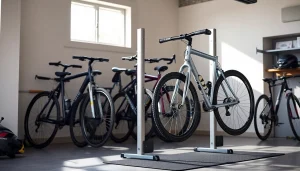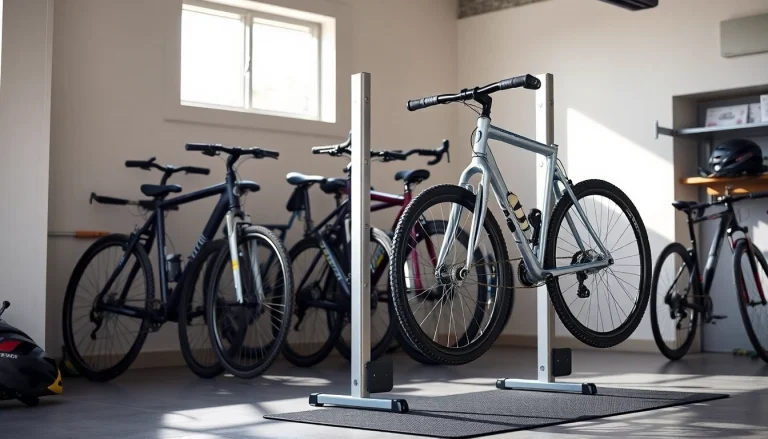Understanding the Vertical Bike Rack: Key Features and Benefits
What is a Vertical Bike Rack?
A Vertical bike rack is a specialized type of bike storage solution designed to securely hold bicycles in a vertical position. This innovative design maximizes space efficiency, making it ideal for individuals with limited storage areas, such as small garages, apartment complexes, or urban environments. Vertical bike racks come in various styles, including freestanding, wall-mounted, and hitch-mounted options, catering to different needs and preferences.
Benefits of Using a Vertical Bike Rack
The advantages of utilizing a vertical bike rack are numerous:
- Space Efficiency: Vertical orientation saves floor space, allowing for more bikes to be stored in a compact area.
- Accessibility: Bikes are easy to lift and retrieve from vertical racks, making loading and unloading hassle-free.
- Protection from Damage: When properly stored, bikes are less likely to accumulate dust or sustain damage from accidental knocks.
- Aesthetics: Vertical racks can complement interior or exterior decor, offering an attractive storage solution.
Key Features to Look For in a Vertical Bike Rack
When selecting a vertical bike rack, consider these essential features:
- Durability: Material quality is crucial; look for racks made from robust materials like steel or aluminum for longevity.
- Weight Capacity: Ensure the rack can support the weight of your bike, especially if it’s heavier due to accessories or an integrated battery.
- Adjustability: Some racks offer adjustable arms or rails to accommodate different bike sizes and styles.
- Ease of Installation: Choose racks that come with clear instructions and require minimal tools for setup.
- Security Features: Look for integrated locking mechanisms to protect your bikes against theft.
Types of Vertical Bike Racks Available
Hitch-Mounted Vertical Bike Rack Options
Hitch-mounted vertical bike racks are perfect for those who frequently transport their bikes using vehicles. These racks attach to the hitch receiver at the back of a car, SUV, or truck. Key considerations include:
- Compatibility: Ensure the rack fits your vehicle’s hitch size (usually 1.25” or 2”).
- Capacity: Many hitch-mounted racks hold between 2 to 5 bikes, making them suitable for family use.
- Adjustable Features: Some racks allow for tilting or folding for easier access to the vehicle’s trunk while the bikes are loaded.
Freestanding Vertical Bike Racks
Freestanding vertical bike racks are suitable for indoor or outdoor use, requiring no permanent installation. Ideal for garages, workshops, or even in front of buildings, these racks typically offer:
- Portability: They can easily be moved as needed, making them flexible for changing storage needs.
- Capacity Options: Available in various sizes, accommodating anywhere from one bike to multiple bikes.
- Stability: Look for units that feature a heavy base or stabilization mechanisms to ensure they do not tip over.
Wall-Mounted Vertical Bike Racks
Wall-mounted vertical bike racks are designed to save floor space by utilizing available wall areas. These racks are ideal for tight spaces and can support various bike types. Here are some notable features:
- Space-Saving: Perfect for homes, apartments, or businesses with limited floor space.
- Easy Access: Bikes can be effortlessly lifted off for immediate use.
- Customizable Design: Many wall-mounted options allow for adjusting the height and orientation to best fit your bikes.
How to Choose the Right Vertical Bike Rack for Your Vehicle
Compatibility with Different Vehicle Types
Selecting a vertical bike rack requires ensuring compatibility with your vehicle. Factors to consider include:
- Vehicle Make and Model: Some racks are designed to fit specific types of vehicles, while others are more universal.
- Hitch Receiver: Verify if your vehicle has a hitch receiver installed, and if so, what size it is.
Capacity Considerations for Your Vertical Bike Rack
Assess your capacity needs based on the number of bikes you plan to store or transport. Consider:
- Family Needs: If transporting multiple family bikes, opt for a rack that supports extra capacity.
- Type of Bikes: Electric bikes or heavier models may require more robust racks with higher weight limits.
Factors Impacting Weight Limitations
Understanding weight limitations is crucial to choosing the right vertical bike rack. Factors that impact these limitations include:
- Material Quality: Racks made from higher-grade materials can typically support more weight.
- Rack Design: Some designs allow for better weight distribution, making them more stable under heavier loads.
Installation and Maintenance of Your Vertical Bike Rack
Step-by-Step Installation Guide
Installing a vertical bike rack can be a straightforward process, depending on the type of rack you choose. Generally, the installation steps include:
- Gather Tools: Ensure you have all necessary tools on hand, such as wrenches, drills, or screwdrivers.
- Read Instructions: Follow the manufacturer’s installation guide thoroughly to avoid errors.
- Attach to Vehicle or Wall: For hitch-mounted racks, connect the rack to the vehicle’s hitch. For wall-mounted racks, install at the appropriate height using wall anchors.
- Secure Tight: Ensure all screws and bolts are tightened to prevent wobbling during use.
Essential Maintenance Tips
Maintaining your vertical bike rack is important for safety and longevity:
- Regular Inspections: Check the rack frequently for signs of wear, corrosion, or loosened bolts.
- Clean Regularly: Remove dirt, dust, and other debris to prevent rust and maintain functionality.
- Reapply Lubricants: For moving parts (if applicable), periodically apply rust-resistant lubricant to enhance performance.
Common Issues and Troubleshooting
Even the best vertical bike racks can encounter issues. Common problems include:
- Wobbling: If the rack is unstable, ensure all bolts are tightened and consider repositioning it.
- Difficulties in Loading/Unloading: Check for obstructions or make adjustments to the rack’s configuration for easier use.
- Incompatibility with Certain Bikes: If you experience difficulty fitting a bike, check the adjustments for optimal fit.
Maximizing the Use of Your Vertical Bike Rack
Best Practices for Loading and Unloading
Loading and unloading bikes properly will enhance safety and convenience:
- Lift with Care: Always lift bikes slowly and balance their weight evenly to avoid strain.
- Secure Before Driving: Double-check that bikes are secured in the rack before transporting.
Tips for Securing Bikes on a Vertical Bike Rack
Safety starts with properly securing your bikes. Tips include:
- Use Proper Straps: Ensure that any straps or locking mechanisms are fully engaged.
- Confirm Stability: Shake the rack gently after securing the bikes to check for stability.
Storage Solutions for Your Vertical Bike Rack
After using your vertical bike rack, consider the following storage options:
- Indoor Storage: If possible, store the rack indoors during extreme weather conditions to prevent wear and tear.
- Winterization: If not in use during colder months, detach the rack and store it in a dry, sheltered area.




















+ There are no comments
Add yours